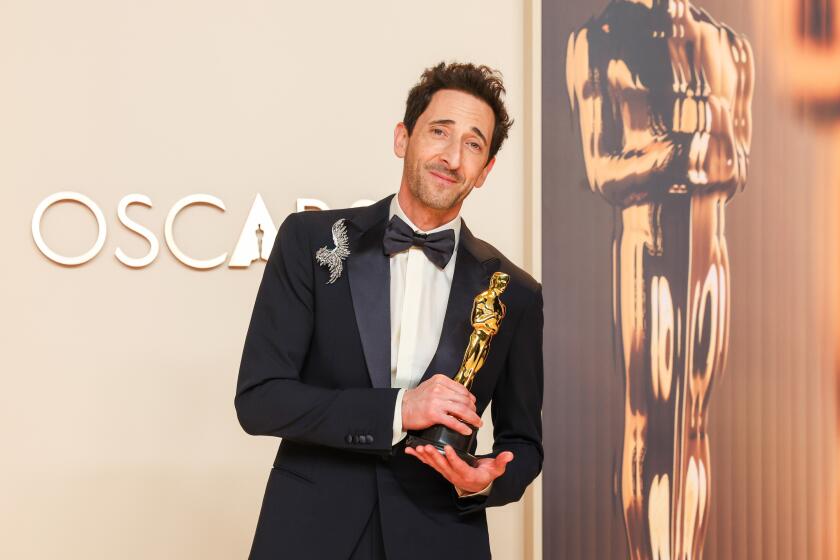‘Ford v Ferrari’ editors keep the tension high, with help from the ‘Zamboni Pass’
- Share via
Director James Mangold’s “Ford v Ferrari” race car epic has a lot of moving parts, and not just on the track. The 2 ½-hour tribute to Le Mans star Ken Miles and genius engineer Carroll Shelby piles conflict upon conflict. Besides the heroes’ schoolyard fisticuffs, the film pits Henry Ford II versus Enzo Ferrari; Shelby versus Ford’s corporate minions pressuring him to compromise his engineering integrity; and hyper-individualist Miles versus the Italian racers as well as the very concept of “teamwork” represented by his fellow American drivers.
Stitching together all those elements in the movie’s climactic 24 Hour of Le Mans competition are co-editors Mike McCusker, who was an Oscar nominee for cutting Mangold’s 2005 biopic “Walk the Line,” and Andrew Buckland, who previously worked on the director’s “The Wolverine.” During a conference call, McCusker and Buckland explain why they edited the race sequence twice, what it’s like to serve as surrogate for the audience, and how they tightened up their final cut with “the Zamboni pass.”
The Le Mans race runs about 30 minutes onscreen but remains suspenseful to the finish line. How did you orchestrate all those shots in your edit?
McCusker: That sequence was essentially cut twice. They only had 2 ½ weeks to film the track stuff in Georgia. The only way to pull that off was by using previz [animated storyboards], which gave us this very clear map of every single shot. Three months before they started shooting, I cut the Le Mans race in previz. Then I recut when the actual footage came in.
You’ve got thousands of edits at Le Mans, timed to the millisecond. How do you decide when to cut from one angle to the next?
McCusker: Some of this is hard to articulate, but when Ken Miles is driving at Le Mans, you just get this innate feeling: “I want to see someone respond, because I want to respond.” The rhythm directs you: “OK, I need a crowd.” It’s a very specific move. “Now I want to see the intensity in his eyes.” As an editor, you put your point of view out there and hope it aligns with the director.
You’re a surrogate for the audience?
McCusker: Right. It’s as if I’m watching the movie: “What do I want to be feeling right now?” We could talk about the details endlessly but mostly it’s driven by the character and the rhythm of the scene. Andrew, what do you think?
Buckland: Once you’re in your chair looking at the footage and cutting, it’s less of an intellectual experience and more of a…
McCusker: Visceral…
Buckland: Visceral feeling. It’s a rhythmic experience.
While James Mangold was shooting the movie in Georgia, you were in L.A. putting together a rough cut as the footage comes in?
McCusker: I think the notion of a “rough cut” is kind of gone. Because we work on computers now, there’s a lot of pressure to show a very refined cut early in the process. I’ll cut action scenes without sound so Jim can make sure he’s getting enough coverage, but for drama scenes, I’ll find the full shape of the scene as early as possible. The little game I play with myself with Jim is, how many scenes can I cut just once? I’ll maybe get one or two of those in each movie.
After production wrapped, James Mangold joined you in the cutting room. What’s that collaboration like?
McCusker: Jim’s not precious about his footage. He’s actually really harsh. He’ll pull stuff he feels is kind of flat, and other times he’ll challenge us to improve scenes that already do work and make them better. Then we sit down as a group with music editors, sound editors. Jim does a free-for-all notes pass, like, for hours. Everyone gets their assignments. And then we do what I call the Zamboni pass.
Zamboni, like the sweeper they use at hockey games to clean the ice?
McCusker: Yeah. We comb through every scene from side to side starting with reel one, and we move all the way through the movie.
Given the complexity of this film, with all its characters and story arcs, how did you shape the pacing?
McCusker: Jim liked to call this movie a reverse “Saving Private Ryan” because we put the big giant action at the tail and open on this small story about friendship that grows in scope as the stakes grow. Introducing all these characters, we had to ask ourselves: Whose scene is it? Particularly with modern audiences, there’s almost a ticking clock where you only have so much time before you exhaust people with set-up. The trick was to find the right alchemy at the front end, when you’re getting to know these guys, so that when you get to the race at the end, we understand why all these characters are doing what they do.
More to Read
Only good movies
Get the Indie Focus newsletter, Mark Olsen's weekly guide to the world of cinema.
You may occasionally receive promotional content from the Los Angeles Times.










